#monodactyle
Explore tagged Tumblr posts
Text
Archovember 2024 Day 7 - Vespersaurus paranaensis
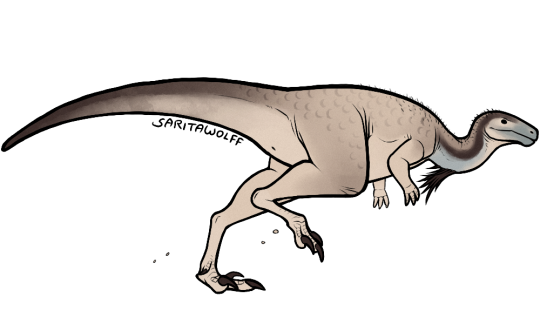
The rare noasaurids were a family of theropod dinosaurs belonging to the group Ceratosauria, and were related to the short-armed abelisaurids. One noasaur, Masiakasaurus, brought the family into the limelight recently with its appearance on Prehistoric Planet. But in Cretaceous Brazil, a different noasaur left its strange, monodactyl footprints across the sand. Vespersaurus paranaensis had two “killing claws”, on each foot, but not like a Velociraptor, or a Balaur, or even like modern Accipitriformes. Instead, it walked on its middle toe, while its 2nd toe and outer toe were raised off the ground. This may have been an adaptation to moving swiftly across the hot sand of the Botucatu Formation, a vast Cretaceous desert. Such an adaption has not been found in any other archosaur. Vespersaurus probably didn’t actually use these claws for hunting, and was likely a generalist, chasing down small, fast animals, opportunistically scavenging the kills of other predators, or hunting weak and injured animals. It may have instead used its claws in powerful defensive kicks, similar to modern cassowaries.
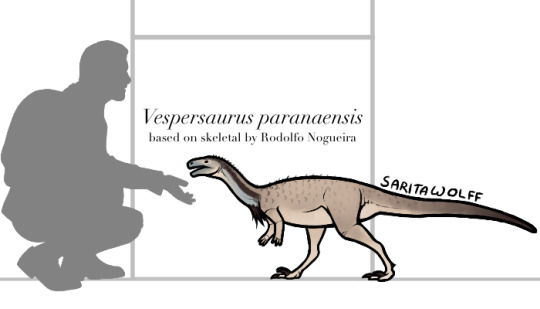
Other named species have yet to be found in the Botucatu Formation. Aside from Vespersaurus, other fossils include indeterminate coelurosaurs, ornithopods, lizards, tritylodontids, and mammals.

This art may be used for educational purposes, with credit, but please contact me first for permission before using my art. I would like to know where and how it is being used. If you don’t have something to add that was not already addressed in this caption, please do not repost this art. Thank you!
#Vespersaurus paranaensis#Vespersaurus#noasaur#noasaurid#theropods#saurischians#dinosaurs#archosaurs#archosauromorphs#reptiles#Archovember#archovember2024#dinovember#Dinovember2024#DrawDinovember#DrawDinovember2024#SaritaDrawsPalaeo#early cretaceous#middle cretaceous#late Cretaceous#brazil#Argentina#Botucatu Formation
20 notes
·
View notes
Note
Goats don’t rlly need horse shoes in the same way horses do because their hooves are adapted to rougher terrain, while horses need them on roads since their hooves are adapted to softer grasslands. They don’t need them but a goat legged character could potentially still wear a version of them for aesthetic/fashion? The also wouldn’t have horseshoes since horses are monodactyl, single-toed, while goats are cloven, two-toed. They could wear something like ox shoes since oxen are also cloven. I have a satyr character so I’ve had to look into this before, hope this helps!
honestly I have no idea if I will ever incorporate shoes into my c!BBH design but I like this ask because it’s teaching me things about hooves and I love to learn . thank you anon <3
#ask#I WAS looking up the diff between horse n goat hooves cuz I was like#I know they’re different but not quiete how#and well I knew they definitely LOOKED different#and now I know the words for it …#monodactyl . cloven … each day I learn some more
13 notes
·
View notes
Photo
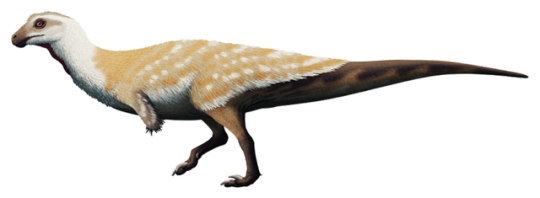
For around 50 years some very unusual dinosaur tracks have been found in ancient desert sediments in South America: strange footprints showing the impression of only a single toe, a walking style never before seen in any reptiles.
And recently a fossil of what might be the track maker has actually been found.
Named Vespersaurus paranaensis, this new species lived during the Late Cretaceous of Brazil (~90 mya) and was a member of the noasaurid family of theropods, closely related to the weird-jawed Masiakasaurus from Madagascar.
Measuring about 1.5m long (~5′), Vespersaurus was fairly lightly built with legs proportioned for running -- and its feet were absolutely unique. Although it had the standard three main toes of a theropod, it bore its weight entirely on the middle toe and held the other digits off the ground. The two raised toes on each foot also had large knife-like claws which may have been used during hunting, vaguely similar to the sickle claws on the feet of dromaeosaurs. But unlike dromaeosaurs these claws weren’t highly curved or pointed, suggesting Vespersaurus used more of a scratching and slashing technique rather than the raptors’ puncture-and-restraint strategy.
Much like ancient horses, it may have developed its single-toed stance as an adaptation for more efficient fast running, possibly to avoid larger predators or to chase down small fast-moving prey like hopping desert mammals.
The known one-toed fossil footprints are actually slightly older than the Vespersaurus fossil, and similar tracks in Argentina have been found dating back to the Late Jurassic (~150mya), so there may have been a long lineage of “one-toed” desert-dwelling noasaurids in South America that haven’t been found yet.
---------
Tumblr | Pillowfort | Twitter | Patreon
#science illustration#paleontology#paleoart#palaeoblr#vespersaurus#noasauridae#abelisauroidea#ceratosauria#theropod#dinosaur#art#monodactyl#horsebirb#speculative fluffiness#feather all the dinosaurs#gotta go fast
243 notes
·
View notes
Note
Hi Simon!
Here’s an addition to the Positivity Corner and Strange Animal Facts.

Horses and humans both evolved from a common ancestor with five digits. Unlike humans, horses have not conserved this evolutionary trait, but instead are known as pseudo-monodactyls.
Interestingly, horses didn’t evolve fewer digits over time. Their digits have merged into one, singular digit. We know this from studying the ridges and splints of horses’ tarsals.
Still, I find this image both hilarious and unsettling to entertain:
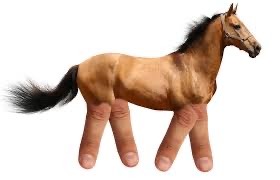
Hahahaha
74 notes
·
View notes
Text
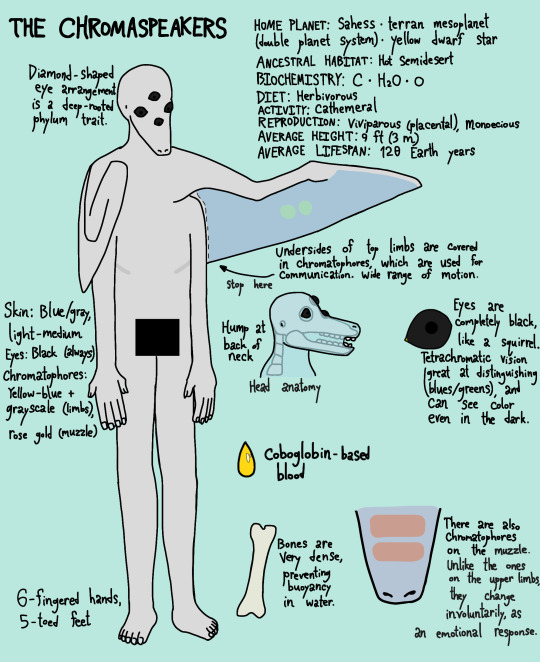
[Image Description: A species reference sheet for the chromaspeakers, an alien species. They have a humanoid body shape, light grey skin, and a long-snouted face with four eyes arranged in a diamond shape. They have a pair of flipper-like limbs where the arms would be on a human, with the actual arms being underneath them. Around the individual shown on the sheet are a bunch of notes and smaller drawings explaining details about the species’ anatomy, which will be summed up in the text below. End ID.]
The chromaspeakers are a humanoid(ish) alien species from the planet of Sahess, located a few hundred light-years from Earth. They are part of the Milky Way Celestial Community, like most of the galaxy’s spacefaring species.
Homeworld conditions: Terran mesoplanet, part of a binary planet system orbiting a yellow dwarf star. Very warm climate, medium-high oxygen levels, same gravity as Earth.
Ancestral habitat: Hot semidesert
Biochemistry: Fairly similar to Earth life, but not completely compatible
Diet: Herbivorous
Activity: Cathemeral (no set cycle)
Reproduction: Viviparous (placental), monoecious (single-sexed)
Average height: 9 ft (3 m) tall
Average lifespan: 120 Earth years
The most notable trait of the chromaspeakers is their method of communication. Their vocal organs are not capable of making complex sounds due to their specific structure; instead, they communicate via the chromatophores on their flipper-like upper limbs. The chromatophores shift between shades of yellow, green, blue, and grey, with each shade and its location/s on the limb marking a different word. Chromaspeakers have tetrachromatic vision that can differentiate between greens and blues much more finely than humans, so subtle distinctions between shades of these colours in particular are used a for a lot of words (which makes most of their languages difficult for humans to interpret… unless the human also has tetrachromacy, I guess). The individual on the ref is saying “hello”.
The upper limbs have a very wide range of motion in the shoulders, so conversation can be held with the other party at different angles relative to the speaker. The elbows and wrists automatically lock into position when fully extended.
In addition to the chromatophores on the upper limbs, chromaspeakers also have two strips of them on top of the muzzle. Unlike the ones on the limbs, the muzzle chromatophores can only change to beige or rose-gold and usually change involuntarily, in reaction to strong emotions (although it’s possible to learn to activate them at will). It has been compared to blushing, though that’s not completely accurate.
Their unusual diamond-shaped eye arrangement is an ancestral trait of their phylum that they can’t really evolve away from. Think how tetrapods can’t just evolve a third set of limbs, it’s a similar kind of deal. Their eyes have a vertebrate-like structure, and are completely black in the same way that a squirrel’s are.
Other anatomy notes:
The skin not covered in chromatophores is light blue or grey. The pigment in it is very effective at preventing sunburn.
6 fingers per hand (with a thumb on either side), 5 toes per foot, communication-limbs are monodactyl
Very dense bones, granting great strength but preventing buoyancy in water.
Coboglobin-based blood - amber yellow when oxygenated, clear when deoxygenated. Chromaspeakers do poorly in cold weather, in no small part because of the heat-dependent nature of coboglobin.
Rounded teeth, all the same shape / size
Noticeable knob / hump at the base of the neck
Some other stuff about them
Chromaspeakers tend to be rather casual about surgery. A prime example is their “antenna implants”, commonly-used neuroprosthetic devices that either grant them extra senses (like magnetoreception or radioreception) or expand their existing senses (for example, hearing ultrasound or picking up polarized light). Also, modern-day chromaspeakers sometimes get surgery on their vocal organs to allow them to speak human/like languages.
Diamond shapes, like the one their eyes are arranged in, frequently show up in their art.
Chromaspeakers initially invented space travel in order to explore Iisaii, the other planet in Sahess’ binary system. Iisaii also bears life, having vast forests visible from space (or from Sahess’ surface). As you can imagine, the sight of a lush otherworld just out of reach resulted in the formation of entire mythologies. The decision to actually go there was… somewhat controversial.
As you can probably guess, the species name is a human-given exonym. The names of their planets are also exonyms, but given by a different alien species. It doesn’t make sense for a species that can’t really speak naturally to have pronounceable-by-humans spoken names for themselves and their world.
#species reference#species design#original species#speculative biology#Celestial Community#The Chromaspeakers
2 notes
·
View notes
Text
Horse evolution Fifty five million years ago during the Eocene epoch period, the Eohippus, a fast, small half meter tall with padded ties with hoofs, exists in the Paleocene Eocene Thermomaximum (Damp rainforests in North America). Perissodactyls - hoofed mammal w/ an odd number of toes/odd toed ungulate • Rhinos • Tapirs • Horses Hyracotherium was the first perissodactyl that is know to man. ⁃ Fossils discovered in England ⁃ Small ungulate ⁃ Named after the resemblance to the rock hyrax Full Eohippus fossil was discovered by O.C. Marsh in 1876. ⁃ Size of a dog ⁃ About 35 cm tall at the shoulder ⁃ Short crowned teeth ⁃ 4 front toes 3 back toes capped with hoofs Equus ⁃ Modern day horse ⁃ Part of Equidae When climate became dryer and cooler, dry grasslands appeared in North America. Mesohippus and Misohippus ⁃ Roamed at same time during the Oligocene Epoch e33.9 to 23 MYA ⁃ Adapted to the climate change ⁃ Mesohippus was about 23 KG ⁃ Misohippus was about 46 KG ⁃ Both lost their 4th front toe and middle toe grew ⁃ Mesohippus disappeared at end of Oligocene epoch Parahippus ⁃ Misohippus ancestor adapted to large plains ⁃ Parahippus leonensis was even better adapted (first true hypsodont) Merychippus ⁃ Descendants of Parahippus ⁃ First true equine (subfamily of equid) ⁃ Taller ⁃ Stood on tip toes ⁃ Could grow to be 450 KG Monodactyls • Stand on one toe • Reduces stress on legs Equus ⁃ Pliocene Epoch ⁃ Modern horse genus ⁃ Dinohippus is the most closely related to modern horses ⁃ Oldest equus is equus simplicidens Great American Biotic Interchange ⁃ Equus Simplicidens migrated to South America and over the Bering land bridge to Russia. Most large animals in North America went extinct in the Pleistocene epoch which went from 2.5 million to 11,700 years ago. 1. Caused by ice age 2. Populations of bison were competition 3. Humans began hunting horses 4. Horses that migrated survived Botai Culture of ancient Kazakhstan began using horses 6,000 years ago. Humans bred horses and brought them back to America. Horses fled and became feral around 1550 and wild horses became a thing in NA again. Natives used them for transport.
Wrote some notes on the evolution of horses because I was bored.... 🐴
22 notes
·
View notes
Photo

Next up on the unicorn tree, we have an, as of now, unnamed species, descended from the unoceratherium (2 image). This species was more adapted to open grasslands than it's predecessors and the two last lines of unicorns, both its descendants, or very close relatives. The previously three hoofed feet are now mainly monodactylous, it's other digits being lifted off the ground, like the artiodactyle posterially positioned toes. It's horned is larger, slightly curved, and is now "twisted" in a corkscrew manner. This species likely went extinct from preassure by climate, hunting, and being out competed by bovids and cervids, and also the other equids like the larger wild horse. . This design is based more off on the split from the equid family while they still had 3-toed hooves and had moved into open grasslands, than the very early split from the forest dwelling ancestors mentioned in my previous post. #art #artist #artistofinstagram #artistoninstagram #paleoartist #fantasyart #unicorn #fantasyscience #fantasy #fantasticbeasts #conceptart #creaturedesign #creaturedesigner #creatureart #wip #workinprogress #sketchbook #sketch #drawing #magicalbeast #magicalcreature https://www.instagram.com/p/B4Kn3hsHaC2/?igshid=ooqk5x5q2by5
#art#artist#artistofinstagram#artistoninstagram#paleoartist#fantasyart#unicorn#fantasyscience#fantasy#fantasticbeasts#conceptart#creaturedesign#creaturedesigner#creatureart#wip#workinprogress#sketchbook#sketch#drawing#magicalbeast#magicalcreature
3 notes
·
View notes
Text
This desert-dwelling dinosaur balanced on single toes
An exceptional Brazilian fossil reveals a dinosaur that walked on one toe like a horse—and tore into meat with knife-like claws.

When Neurides Martins brushed the sediment from the tiny tooth, she knew she had found something special.
That tooth was the first piece of a new species of dinosaur, and an unusual one. Roughly the size of a Great Dane, the carnivore would have roamed the desert some 90 million years ago, walking upright on two legs and resting its weight on just one long clawed toe, the middle toe of three.
Almost 50 years ago, paleontologists found mysterious one-toed footprints in the region, but until now, no one knew what creature had made them. While its three functioning toes make the new species a theropod dinosaur like Tyrannosaurus rex, this rare anatomy makes it function essentially as if it were monodactyl, or one-toed, an adaptation that had not yet been recorded among Brazil’s dinosaurs.
Named Vespersaurus paranaensis for the city and state where it was found, the dinosaur is also the first found in Brazil’s Paraná region and the most complete and best-preserved theropod dinosaur found in Brazil so far. Martins and colleagues described the dinosaur and its environment June 26 in the journal Scientific Reports.
Continue reading.
8 notes
·
View notes
Photo


( via / via )
Rainy days 🌧️.
"Solve this riddle: What has a thighbone and a nostril, but not a shoulder?" --@magicrealismbot
Insect insight.
"Trilce X.
The pristine and last stone of groundless fortune, has just died with soul and all, October bedroom and pregnant. Of three months of absent and ten of sweet. How destiny, mitered monodactyl, laughs.
How at the rear conjunctions of contraries destroy all hope. How under every avatar's lineage the number always shows up.
How whales cut doves to fit. How these in turn leave their beak cubed as a third wing. How we saddleframe, facing monotonous croups.
Ten months are towed toward the tenth, toward another beyond. Two at least are still in diapers. And the three months of absence. and the nine of gestation.
There's not even any violence. The patient raises up and seated empeacocks tranquil nosegays."
--Eshleman's Vallejo
Amazing AI-generated commercial (thread). Bring it on!
0 notes
Link
#paleontology#vespersaurus#noasauridae#abelisauroidea#ceratosauria#theropod#dinosaur#new species#monodactyl#horsebirb
97 notes
·
View notes
Photo

"Notable Deaths" according to wikipedia
by monodactyl
10 notes
·
View notes
Video
'Still Life in the Shape of a Monodactylous Pachyderm (after Satie)'
0 notes
Text
Is One Toe Really Better Than Three? How Horses’ Legs Evolved for Endurance Travel Rather Than Speed
Is One Toe Really Better Than Three? How Horses’ Legs Evolved for Endurance Travel Rather Than Speed
The ancestors of horses (including asses and zebras) had three toes on each foot. Because only single-toed (monodactyl) forms survive today this anatomy has been perceived as a superior evolutionary outcome, enabling horses to outrun predators.
But our interpretation of equine evolution may be biased by our own history with horses: performance at the racetrack has been less important for human…
View On WordPress
0 notes
Photo
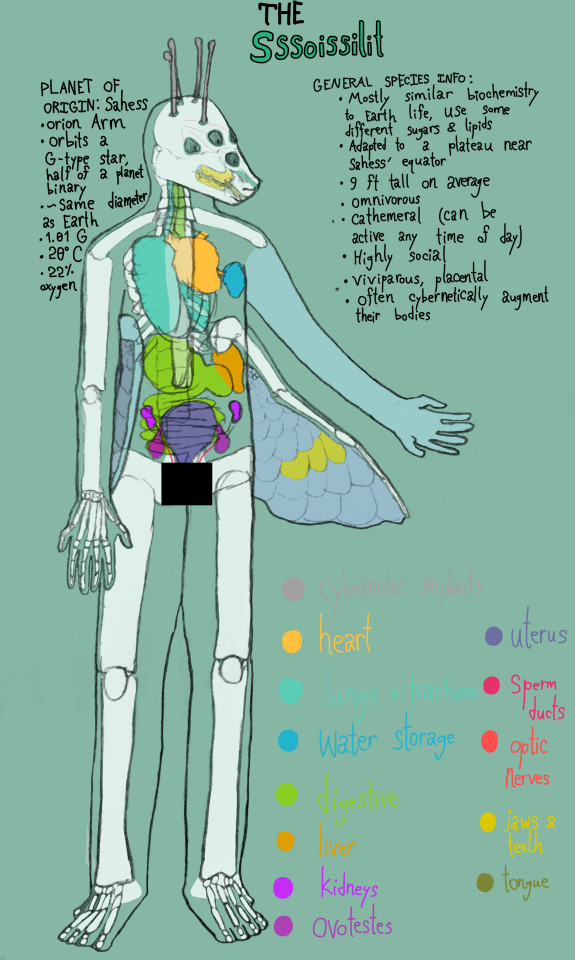
A ref I made back in August for one of my sapient alien species, the sssoissilit!
Detailed description under the cut.
GENERAL INFO:
Biochemistry: Carbon-based, water as solvent, oxygen respiration, DNA coding, chiral chemistry. Different enough to be incompatible with Earth life-forms, though.
Body plan: Bilateral, bipedal, semi-humanoid
Diet: Omnivorous
Activity: Cathemeral
Average size: 9 ft (3 m) tall
Average lifespan: 120 Earth years
Sociality: Highly social
Other notable traits: Often augment their bodies with cybernetics
HOMEWORLD: The sssoissilit come from Sahess, a planet a few hundred light-years from Earth.
Sahess orbits a main-sequence yellow dwarf star, and is notably part of a planetary binary system; it and its sister planet, Iisaii, orbit around each other like they orbit their sun. The gravitational forces give both planets severe tides, so many of their terrestrial species (Iisaii also bears life, though not quite as advanced as Sahess' - think Mesozoic as opposed to Cenozoic) prefer higher altitudes. Water erosion has made the coastlines into steep cliffs, and there are many sessile life-forms adapted to cling to them at low tide. The sssoissilit evolved on a vast plateau near the planet’s equator.
Sahess is roughly the same size as Earth, and its gravity is only 1% higher. The average surface temperature is 20 degrees Celsius (6 degrees higher than Earth), and its atmosphere is made up of 22% oxygen (2% higher than Earth).
SKELETAL / MUSCULAR: Sssoissilit have very dense bones and strong muscles, giving them enormous physical power but making them incapable of swimming, climbing, or jumping. Because of this, they instinctively fear water and heights (their native plateau obviously exempted, since it's mostly flat).
They are hexapods, having one pair of arms, one pair of communication-sails (more on that in the “Integumentary” section), and one pair of legs. The hands and hexadactyl, having a thumb on either side, the feet are pentadactyl with the outermost toe being stubby, and the communication-sails are monodactyl. They walk plantigrade.
The bones of their snout are one solid piece along the sides, similar to a seahorse - the jaws that they use to eat are derived cartilaginous structures, which they pop out of their mouth by pushing back the flesh around it (it flattens very easily). When fully extended, they can open and close the cartilage jaws to an impressive degree, though they cannot breathe while doing so since the nostrils are squeezed shut when they fold their “lips” back.
CARDIOVASCULAR: The five-chambered heart of a sssoissilit is located around the centre of their chest. They use coboglobin instead of hemoglobin to transport oxygen, making their blood clear when oxygenated and amber-yellow when deoxygenated. Since coboglobin works best in hot environments, sssoissilit do poorly in cold weather.
RESPIRATORY: Similar to Earth mammals, though the left lung is oddly posterior to / diagonally “tilted” as relative to the right. The larynx is somewhat underdeveloped.
DIGESTIVE: The cartilage jaws contain a mix of piercing and grinding enamel teeth. They extend the jaws to snap up food and retract them back into their head to chew. Their tongues are flat and cannot be raised far from the floor of the mouth.
NERVOUS: Structurally similar to Earth chordates, though they use a different set of neurotransmitters and have very high neuroplasticity / rates of successful recovery from brain injuries.
INTEGUMENTARY: Sssoissilit are entirely covered in smooth skin with no upper covering, always light blue or grey in colour (aside from the chromatophores on the sails). They also lack claws, nails, or any other features along these lines.
The skin on the sails is thicker than usual and folded over to form sections that resemble large scales at a glance, and covered in chromatophores used for communication - the individual in this picture is saying “hello”. The chromatophores can turn any shade of yellow, green, or blue, as well as darken to black. Changing the colour of an entire section is easier than changing specific tiny spots, so simpler words / concepts get communicated the way you see on the model (entire segments changing) while more complex ideas are communicated with smaller patterns.
SENSES
Vision: The four eyes of a sssoissilit have a distinctive T-shaped arrangement, a trait of their phylum which is reflected in a lot of their art and general aesthetics. The eyes are vertebrate-style camera eyes, not compound - they are just completely black, like those of a squirrel. They cannot see red, but can distinguish very well between different shades of yellow, blue, and green. Night vision is also great.
Hearing: Possessing no external ear openings, sssoissilit naturally have dull hearing.
Smell / Taste: Chemoreceptors are present on the entire outside of the head, as well as inside the mouth and sinus cavities.
Touch: Also fairly dull due to their thick skin, though the hands are more sensitive.
REPRODUCTIVE: Sssoissilit are a monoecious species, all individuals having ovotestes. They are viviparous, specifically placental, usually giving birth to a single child after a 14-Earth-month pregnancy. Children are born as miniature versions of the adults, and can eat solid food as soon as they are born.
MISCELLANEOUS: Sssoissilit have an organ next to their heart made of spongy tissue. During the dry season, this organ stores water that's been filtered by the kidneys.
NOTABLE TECHNOLOGY: The antennae on top of this individual's head are a very common body modification of the neuroprosthetic variety. They're essentially made to be auxiliary sensory organs, with all sorts of different models. They can be made to sense temperature, magnetic fields, radiation, sound, and more. The procedures involved in getting them installed are quite intensive - first neurons need to be artificially grown inside the antennae, then holes need to be cut in the skull during the surgery, and after that the neurons in the antennae need to grow with those in the brain. However, due to the species' very high neural plasticity and skill with surgery, this process is much, much less fraught than it sounds. Though the ethics of it are hotly debated, some parents in recent times even have it done to their babies.
The sssoissilit are a space-faring civilization, though they are restricted by the fact that they have not yet invented wormholes, and part of the Milky Way Celestial Community. They have several space elevators going to Iisaii.
#original art#original species#worldbuilding#speculative biology#sci-fi#aliens#Tributaries#Sssoissilit#ask to tag
2 notes
·
View notes
Text
Quick : Is one toe really better than three? How horse’ legs evolved for travel rather than speed — ScienceDaily
//pagead2.googlesyndication.com/pagead/js/adsbygoogle.js
(adsbygoogle = window.adsbygoogle || []).push({});
best –
Palaeobiologists from the University of Bristol and Howard University (USA) have uncovered new evidence that suggests that horses’ legs have adapted over time to be optimised for endurance travel, rather than speed.
The ancestors of horses (including asses and zebras) had three toes on each foot. Because only single-toed (monodactyl) forms survive today this anatomy has been perceived as a superior evolutionary outcome, enabling horses to outrun predators.
But our interpretation of equine evolution may be biased by our own history with horses: performance at the racetrack has been less important for human history than the endurance of horses at slower speeds, and such endurance may have been the critical factor in horse evolution.
The research team combined evidence from the fossil record with existing studies on horse locomotion and propose that the adaptive significance of single-toed limbs was for trotting during roaming for food and water, rather than for galloping to avoid carnivores.
The real evolutionary ‘step forward’ in horse foot anatomy was not the loss of additional toes, but the evolution of the ‘spring foot’.
This pogo-stick type of foot anatomy evolved in the three-toed distant ancestors of modern horses, which sported an enlarged central toe but retained small ‘side toes’, which likely prevented the foot from over-extending during extreme locomotor performance.
The ‘spring foot’ enables the storage of elastic energy in the limb tendons during locomotion, and its evolution coincided with the spread of grasslands around 20 million years ago in North America (the original home of horse evolution).
The spring-footed horses radiated extensively and were as diverse during their time as antelopes in Africa today.
By around 11-million-years ago they also spread into Eurasia and Africa, where they eventually included forms larger than a modern horse. But only the lineage leading to modern horses, one amongst many, showed any tendency to reduce the number of toes.
If being single-toed was evolutionary advantageous, why did the majority of horses retain the three-toed condition for most of their evolutionary history?
Professor Christine Janis, lead author from the University of Bristol’s School of Earth Sciences (and also affiliated with Brown University, USA) said: “Early members of the single-toed horse lineage were not only losing their side toes, but the bones of the remaining central toe showed evidence of the boosting-up of the ‘spring foot’ apparatus, implying that these horses were becoming more reliant on energy-efficient locomotion.
“But at the same time these horses’ backs were becoming shorter and stiffer, contraindicative of adaptation for the back-flexing fast galloping gait. Rather, the preferred locomotion was more likely the medium-speed trot.”
The authors propose that the early single-toed horses were changing their daily foraging behaviour to roam more widely in search of food, promoting energy-saving adaptations in their feet.
The loss of the side toes may simply have been a consequence of upgrading the anatomy of the main, central toe, and with the boosted-up ligament system their original function was no longer necessary.
Single-toed horses appeared in North America around 12-million-years ago. Over the next few million years they radiated alongside three-toed horses but remained pony-sized and were neither diverse nor numerous.
But at this time the climate in northern latitudes was becoming cooler and drier. An increase in roaming behaviour would promote selection for the energy-efficient single-toed foot.
At the time, the foraging behaviour of the single-toed horses would have been one adaptive strategy among an equine diversity, much as different kinds of antelope have different modes of foraging today.
But by around five million years ago the cooling and drying trend became more intense worldwide; the former great diversity of three-toed horses had dwindled, and the direct ancestor of modern horses (early species of the genus Equus) appeared. By a million years ago all lineages of three-toed horses were extinct.
Why were single-toed horses the only equine lineage to survive to the present day? It is unlikely that competition was involved between the differently-adapted equines, as the Old World three-toed horses started their decline several million years before Equus emigrated from North America to join them 2.5 million years ago. More likely, the climatic changes of the late Cenozoic favoured the evolutionary strategy of the single-toed horses.
Professor Ray Bernor, the co-author of the paper, from Howard University’s College of Medicine, notes that the single-toed horses really just got a lucky break due to changing climates.
He added: “The three-toed horses, especially the Old World hipparions, were an incredibly successful radiation, and their skeletons showed adaptations for leaping and springing as well as running. But they evolved for a world that was warmer and wetter than that of today, and like many other large mammals did not survive to the present day.”
Single-toed horses became the dominant equines across the world in the past couple of million years, and only went extinct in the Americas at the end of the Pleistocene, around 12,000 years ago.
Professor Janis added: “However, nobody could have foreseen this eventual success ten million years ago, when single-toed horses were merely a minor lineage among equines, confined to North America.
“Their foot anatomy was ultimately important for finding food, rather than for avoiding becoming food themselves.”
//pagead2.googlesyndication.com/pagead/js/adsbygoogle.js
(adsbygoogle = window.adsbygoogle || []).push({});
Whats New Get Started Cancel Anytime
Quick : Is one toe really better than three? How horse’ legs evolved for travel rather than speed — ScienceDaily
from Secret Of Pet All Goods For Our Friends
0 notes
Text
Researchers Discover Two New Chinese Dinosaurs: Bannykus computer and Xiyunykus
www.inhandnetworks.com
Bannykus restoration (Image by SHI Aijuan)
Digit reduction occurs many times in tetrapod evolution, and the most famous example is the ‘horse series’ of North America. An international research team announced the discovery of two new Chinese dinosaurs: Bannykus and Xiyunykus, in the journal Current Biology, which shed light on how alvarezsaurian dinosaurs reduced and lost their fingers.
The new dinosaurs are based on two fossils collected by a joint research team led by XU Xing from the Institute of Vertebrate Palaeontology and Palaeoanthropology (IVPP) of the Chinese Academy of Sciences. Xiynykus was discovered in 2005 in Zhunggar Basin, northwestern China, and Bannykus was discovered a few years later in 2009 in western Inner Mongolia, north-central China.
The new Alvarezsaurian dinosaurs are among the most bizarre groups of theropods, with extremely short, robust forelimbs with a single functional claw and gracile, bird-like skulls and hindlimbs. These specializations have led to controversy about their phylogenetic placement, biogeographic history, and ecological role in Mesozoic ecosystems.
AT early times, unspecialized alvarezsaur fossils were the key to resolving this controversy, but until recently the group had at least a 90 million year gap in its fossil record, especially during the Early Cretaceous.
Bizarre hand of Bannykus (Image by XU Xing)
The new dinosaurs fall nearly at the midpoint of the 90-million year temporal gap between the earliest and latest alvarezsaurs. They contribute key phylogenetic and biogeographic information that firmly resolves Alvarezsauria as a monophyletic clade originating in Asia and dispersing to other continents.
The new findings show that clear anatomical specializations also present in later members of the clade, such as a hypertrophied first digit, mechanically efficient forearm, and robust humerus. However, they preserve plesiomorphic forelimb proportions not present in later-branching members.
Xiyunykus skeleton line drawing (Image by SHI Aijuan)
Together, these observations document a major macroevolutionary shift from the plesiomorphic theropod condition of a relatively long arm and grasping hand in the earliest alvarezsaurs (e.g., Haplocheirus), to a long arm with a specialized hand in Bannykus and Xiyunykus, to the highly specialized short-l Vending Computer imbed, functionally monodactyl hand in the latest evolving members of the clade. “This transition plays out in an incremental fashion over more than 50 million years,” said XU, “it could one day potentially serve as a classic example of macroevolution akin to the ‘horse series’ of North America.” “Alvarezsaurs are weird animals,” said Dr. Jonah Choiniere from the University of the Witwatersrand of South Africa, a co-author of the report, “with their strong, clawed hands and weak jaws, they appear to be the dinosaurian analogue to today’s aardvarks and anteaters.”
But the earliest alvarezsaurs had more typical, meat-eating teeth and hands useful for catching small prey, and only later-evolving alvarezsaurs evolved a hand with a huge, single claw capable perhaps of tearing open rotting logs and anthills. Bannykus and Xiyunykus are important because they show transitional steps in the process of alvarezsaurs adapting to new diets. “The fossil record is the best source of information about how anatomical features evolve,” said James Clark from George Washington University, “and like other classic examples of evolcashless vendingution such as the ‘horse series,’ these dinosaur Overhead Line Monitoring s show us how a lineage can make a major shift in its ecology over time.”
From left to right: Haplocheirus, Xiyunykus, Bannykus, and Shuvuuia. Note the lengthening of the jaws, reduction of the teeth, and changes in the hand and arm. Viktor Radermacher
Dr. Roger Benson from the University of Oxford said, “The new fossils have long arms, showing that alvarezsaurs evolved short arms only later in their evolutionary history, in species with small body sizes. This is quite different to what happens in the classic example of tyrannosaurs, which have short arms and giant size.”
Publication: Xing Xu, et al., “Two Early Cretaceous Fossils Document Transitional Stages in Alvarezsaurian Dinosaur Evolution,” Current Biology, 2018; DOI:10.1016/j.cub.2018.07.057
din rail mounting, ul certified, fcc certified, ptcrb certified, verizon wireless certified, att certified, ce certified-, emark certified, azure iot certified, cost effective, ipv6, python programming, reliability, security, high-speed, lte cat 1, router, gateway, routers, cellular gateway, modem, hardware, software, cloud platform, applications, ethernet switch, managed switch, vehicle router, car router, dtu, data terminal unit, computer, vending computer, vending pc, manufacturer, manufacturing, android computer, iot, industrial iot, industrial internet of things, m2m, industrial m2m, m2m communication, remote communication, wireless m2m, remote connectivity, remote access, m2m connectivity, iiot, industrial networking, industrial wireless, m2m iot, smart vending, touchscreen vending, cloud vms, telemeter, vending telemetry, cashless vending, light industrial, commercial, distribution automation, distribution power line monitoring, fault location, fault detection, da monitoring, smart grid, transformer monitoring, intelligent substation, goose messaging, remote machine monitoring, remote secure networks, remote secure networking, secure web based scada , remote diagnostics, remote maintenance, plc programming, intelligent traffic enforcement, ct scanners remote monitoring, mri remote monitoring, healthcare, wireless atm, branch networking, retail, digital signage, wastewater treatment, remote monitoring, industrial automation, automation, industrial transport, inhand, inhand network, inhand networks, Industrial IoT, IIoT, Industrial IoT Manufacturer, Industrial IoT Connectivity, Industrial IoT Products, Industrial IoT Solutions, Industrial IoT Products, industrial IoT Gateway, industrial IoT router, M2M IoT gateway, M2M IoT router, industrial router, Industrial IoT Router/Gateway, industrial IoT Gateway, industrial LTE router, Industrial VPN router, Dual SIM M2M router, Entry level Industrial Router, Cost effective, 3G 4G LTE, WiFi, VPN industrial router for commercial and industrial and M2M/IoT applications, Industrial 3G Router,
#intelligent-traffic-enforcement#low-cost cellular router#wireless ATM modem#Dual SIM M2M router#industrial cellular modem3g modem#Remote Automation#industrial l2tp cellular router#wireless ATM solutions
0 notes